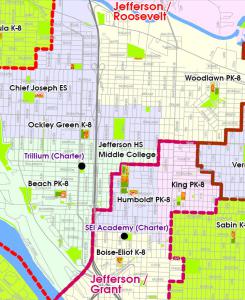 Enrollment balancing 2012-2014: What it means for your school
Enrollment balancing 2012-2014: What it means for your school
Each year a new group of children starts kindergarten at Portland Public Schools, and each year a senior class graduates. Families also move around. In addition, PPS enrollment is growing. These shifts result in schools with too many or too few students. Enrollment data from October show that many PPS elementary, middle and K-8 schools are smaller or larger than enrollment targets. PPS plans to balance enrollment over several years— possibly by shifting school boundaries, adding space or changing grade configurations. The Portland School Board must approve any changes.
Schools that may be affected
First up for consideration will be schools where enrollment discussions began last year: ACCESS Academy, Alameda Elementary School, Beaumont Middle School and Sabin, Rigler and Vernon K-8 schools. Changes at these schools may impact surrounding schools: Irvington, Roseway Heights and Scott K-8 schools. In 2012, enrollment balancing will expand to other schools with high growth or low enrollment, with changes taking effect in 2013.
Factors that influence enrollment balancing
Schools are different sizes — School buildings vary greatly, from eight classrooms to nearly 100.
School funding follows students — The state of Oregon regulates school funding, which is largely provided on a per-student basis. That means that the number of teachers is closely tied to the number of students.
School size targets: A guideline, not a rule — The district is working to develop target enrollment ranges for schools that will help ensure an adequate number of teachers. However, limitations of building size and geography mean that these targets can only be part of the answer.
Community input — Numbers don’t tell the whole story. Schools are important community centers, and Portlanders have strong feelings about their neighborhoods.
Details and latest information: pps.net (click “Enrollment Balancing” at bottom left)
Comments or questions: enrollment-office@pps.net
Community meetings
PPS invites questions and input at the following meetings.
For the latest meeting schedule, go to pps.net (click “Enrollment Balancing” at bottom left) or email enrollment-office@pps.net.
Oct. 27, 6-7:30 p.m. Sabin PK-8 School auditorium, 4013 N.E. 18th Ave.
Nov. 2, 6-8 p.m. Rigler K-8 School auditorium, 5401 N.E. Prescott St.
Nov. 3, 6:30-8 p.m. Alameda Elementary School cafeteria, 2732 N.E. Fremont St.
Nov. 7, tentative date, time to be determined Irvington K-8 School, 1320 N.E. Brazee St.
Nov. 8, time to be determined Beaumont Middle School, 4043 N.E. Fremont St.
Vernon PK-8 School, time and date to be determined
 How can the parents and public be involved?
How can the parents and public be involved?
